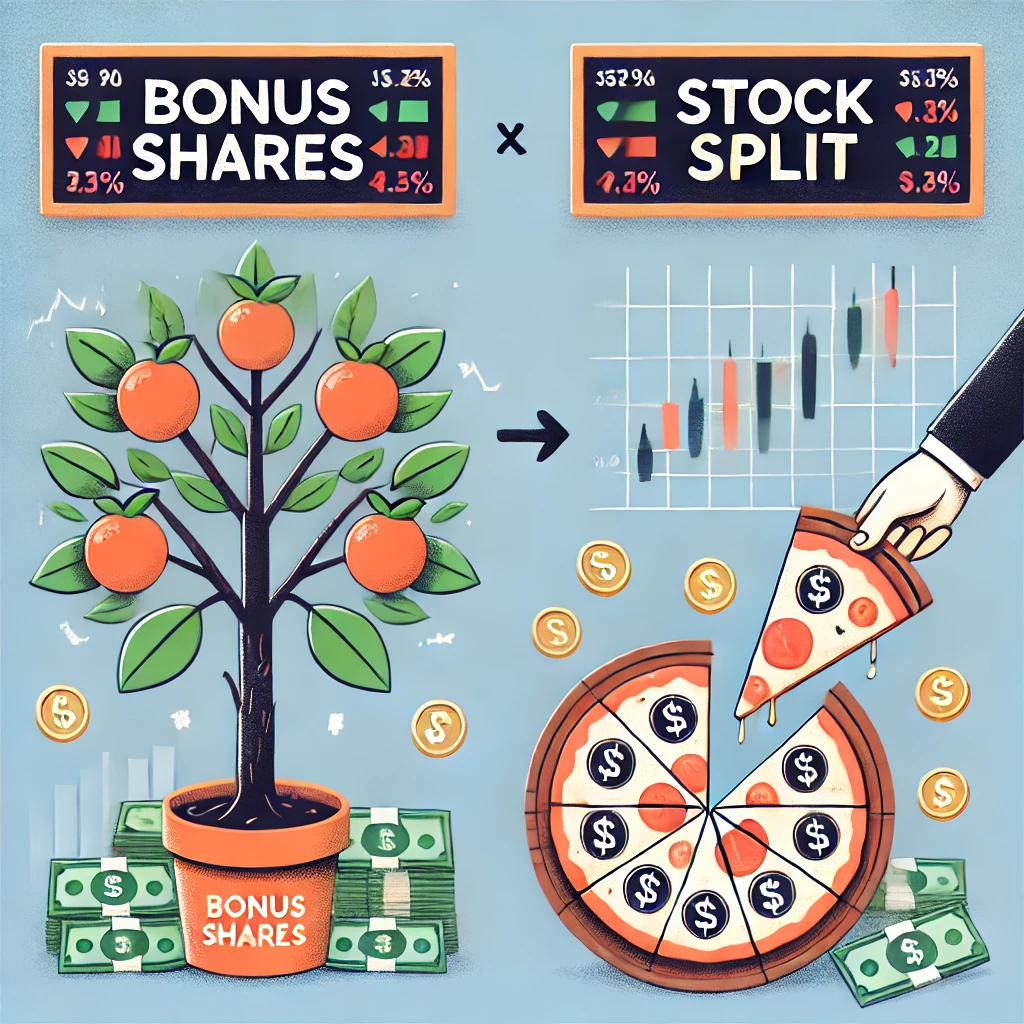What is bonus share and split share
Stock investors always try to take advantage of “Bonus Shares” and “split shares” announcements made by companies. Their primary purpose is to extract profit from it. Companies use these practices of bonus shares and split shares to reward their shareholders. While both of these practices can benefit investors, they serve different purposes and have different implications. In this article, we will deep dive into the world of bonus shares and split shares, exploring their advantages and disadvantages.
What is Bonus Share?
Bonus shares are additional shares issued by the company to its existing shareholders. They are issued free of cost and distributed in a specific ratio determined by the company’s management.
For example, if a company declares a 1:2 bonus issue, it means that for every 1 share held by an investor, they will receive an additional 2 shares.
Bonus shares are issued from the company’s reserves, such as retained earnings or share premium accounts. The issue of bonus shares does not involve any cash transaction. Investors don’t pay anything to receive these additional shares.
What is Split Share?
Split shares are also known as stock splits. In a Split share, the Company divides its existing shares into a larger number of shares. This is done to make the shares more affordable and attractive to investors.
For example, if a company declares a 2-for-1 stock split, it means that for every one share held by an investor, they will receive two shares. The split ratio is exactly the reverse of that of the Bonus share ratio.
Unlike bonus shares, split shares do not change the company’s capital structure or increase its share capital. The company’s total market value remains the same, but the number of outstanding shares increases.

Key Differences between Bonus Shares and Split Shares.
| Point of Comparison | Bonus Share | Split Share |
| Definition | Additional shares are issued to existing shareholders free of cost from the company’s reserves. | No change in the ownership percentage of shareholders. |
| Purpose | To capitalize retained earnings and reward shareholders. | To increase liquidity and make shares more affordable. |
| Effect on Face Value | Face value remains the same. | Face value reduces proportionally. |
| Effect on Market Price | Market price generally decreases as more shares are available. | Market price reduces in proportion to the split ratio |
| Impact on Share Capital | Increases as new shares are issued. | Share capital remains unchanged as no new shares are issued. |
| Change in Ownership Percentage | No change in the ownership percentage of shareholders | No change in ownership percentage of shareholders |
Advantages of Bonus Shares
1. Share Capital Increases: Bonus shares increase the number of shares held by investors, which can lead to increased dividends and voting rights.
2. Reward for Existing Shareholder: Bonus shares are rewards from companies to their shareholder. This increases investor’s loyalty and support towards the company.
3. Increased Liquidity: Bonus shares increase the liquidity of the company’s shares, making it easier for investors to buy and sell shares.
Disadvantages of Bonus Shares
1. Dilution of Shareholding: Bonus shares can lead to a dilution of shareholding, as the number of outstanding shares increases.
2. Decrease in Share Price: Bonus shares can lead to a decrease in the share price, as the number of outstanding shares increases.
3. Increased Costs: Bonus shares can increase the costs associated with share ownership, such as brokerage fees and stamp duty.
Advantages of Split Shares
1. Increased Affordability: Split shares make the shares more affordable and attractive to investors, which can lead to increased demand and a higher share price.
2. Increased Liquidity: Split shares can increase the liquidity of the company’s shares, making it easier for investors to buy and sell shares.
3. Psychological Impact: Split shares can have a positive psychological impact on investors, as the lower share price can make the shares appear more attractive.
Disadvantages of Split Shares
1. No Change in Company’s Value: Split shares do not change the company’s value or its financial performance.
2. Increased Costs: Split shares can increase the costs associated with share ownership, such as brokerage fees and stamp duty.
3. Possibility of Decreased Share Price: Split shares can lead to a decreased share price, as the number of shares outstanding increases.
Conclusion
Companies use the practice of “Bonus shares and split shares” to reward their shareholder. They have the intention of making their share more attractive. While both practices have their advantages and disadvantages, they serve different purposes and have distinct implications. Investors should carefully consider the implications of bonus shares and split shares before making any investment decisions. It is always wise to take the advice of a qualified Financial advisor for making important investment decisions.
Q1: What is the main difference between bonus shares and split shares?
A1: Bonus shares are additional shares issued to existing shareholders, while split shares divide existing shares into a larger number of shares.
Q2: Why do companies issue bonus shares?
A2: Companies issue bonus shares to reward their existing shareholders, increase the liquidity of their shares, and make their shares more attractive to investors.
Q3: What is the impact of bonus shares on the share price?
A3: The issue of bonus shares can lead to a decrease in the share price, as the number of shares outstanding increases.
Q4: Why do companies split their shares?
A4: Companies split their shares to make them more affordable and attractive to investors, increase the liquidity of their shares, and potentially increase the share price.
Q5: What is the impact of split shares on the company’s value?
A5: Split shares do not change the company’s value or its financial performance. The total market value of the company remains the same.
Q6: Do bonus shares and split shares affect the shareholder’s ownership percentage?
A6: Bonus shares can increase the shareholder’s ownership percentage, while split shares do not affect the shareholder’s ownership percentage.
Q7: Are bonus shares and split shares taxable?
A7: Bonus shares are tax-free in the hands of investors, while split shares do not have any tax implications.
Q8: Can investors sell their bonus shares immediately?
A8: Yes, investors can sell their bonus shares immediately, but it’s essential to check the company’s rules and regulations regarding the sale of bonus shares.
Q9: How do bonus shares and split shares affect the company’s financial statements?
A9: Bonus shares can increase the company’s share capital, while split shares do not affect the company’s financial statements.
Q10: Which is better, bonus shares or split shares?
A10: Both bonus shares and split shares have their advantages and disadvantages. The better option depends on the investor’s individual circumstances, investment goals, and risk appetite.
Major bonus share issues in the Indian stock market for 2025:
1. KBC Global Ltd: 1:1 bonus ratio, announced on March 7, 2025, with a record date of March 28, 2025.
2. Dhanalaxmi Roto Spinners Ltd: 1:1 bonus ratio, announced on March 13, 2025, with a record date of March 26, 2025.
3. Greenlam Industries Ltd: 1:1 bonus ratio, announced on March 12, 2025, with a record date of March 21, 2025.
4. Padam Cotton Yarns Ltd: 2:3 bonus ratio, announced on February 28, 2025, with a record date of March 18, 2025.
5. SBC Exports Ltd: 1:2 bonus ratio, announced on February 28, 2025, with a record date of March 10, 2025.
6. Pradhin Ltd: 2:1 bonus ratio, announced on February 28, 2025, with a record date of March 7, 2025.
7. Vantage Knowledge Academy Ltd: 2:1 bonus ratio, announced on February 28, 2025, with a record date of March 5, 2025.
8. Anand Rathi Wealth Ltd: 1:1 bonus ratio, announced on February 24, 2025, with a record date of March 5, 2025.
9 Jindal Worldwide Ltd: 4:1 bonus ratio, announced on February 21, 2025, with a record date of February 28, 2025.
10. Gujarat Toolroom Ltd: 5:1 bonus ratio, announced on February 13, 2025, with a record date of February 18, 2025.
Major stock splits in the Indian stock market for 2025:
1. Shukra Pharmaceuticals Ltd: 10:1 split ratio, announced on January 29, 2025, with a record date of March 21, 2025.
2. Last Mile Enterprises Ltd: 10:1 split ratio, announced on January 16, 2025, with a record date of March 21, 2025.
3. Optimus Finance Ltd: 10:1 split ratio, announced on January 17, 2025, with a record date of March 21, 2025
4. Softrak Venture Investment Ltd: 10:1 split ratio, announced on January 10, 2025, with a record date of March 21, 2025.
5. Blue Pearl Agriventures Ltd: 10:1 split ratio, announced on January 30, 2025, with a record date of March 20, 2025.
6. Sika Interplant Systems Ltd: 10:2 split ratio, announced on August 9, 2024, with a record date of March 17, 2025.
7. Shangar Decor Ltd: 5:1 split ratio, announced on January 20, 2025, with a record date of March 14, 2025.
8. Shalimar Agencies Ltd: 10:1 split ratio, announced on January 15, 2025, with a record date of March 14, 2025.
9. Mehai Technology Ltd: 10:1 split ratio, announced on January 24, 2025, with a record date of March 14, 2025.
10. IOL Chemicals & Pharmaceuticals Ltd: 10:2 split ratio, announced on December 27, 2024, with a record date of March 11, 2025.
The reader would also like to know the following topic
Nifty 50 vs Nifty Next 50 vs Nifty 100
Bull vs Bear in the stock market


Great information about finance and investment.